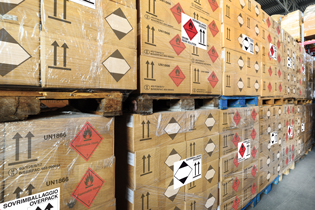Overpack: definition and practical examples

When shipping dangerous goods or more generally any goods packed in packages, it tends, for reasons of convenience both in storage and in shipment, to group multiple packages to the same consignee in a single unit. This unit, in the field of dangerous goods, takes the name of Overpack, in English, and must be reported in accordance with the Regulations. Specifically, these units must be labeled with Overpack labels and all other labels and marks for dangerous goods associated with the goods enclosed inside. It should be specified that, only for shipping by air IATA of more than one overpack, must be assigned to each of them a name that should appear alongside the Overpack.
What is an Overpack?
Overpack is an enclosure used by a single shipper to contain one or more packages and to form one handling unit for convenience of handling and stowage.
Example of overpack:

a pallet on which are arranged more packages, stacked and | an outer protective packaging such as a box or a crate. |
Transport in accordance with chapter. 3.4 ADR, RID, ADN and IMDG


Transport of Dangerous Goods

 Note: these pictures are just examples for marking Overpacks.
Note: these pictures are just examples for marking Overpacks.
Overpack must be marked with the word “Overpack” (font 12 mm) and with the mark of limited quantities as required for packages. The mark “OVERPACK”, which must be easily visible and legible, must be in the official language of the country of origin and in international transport also in English, French or German (unless agreements between countries provide otherwise) (ADR 5.1.2.1 to, RID 5.1.2, 5.1.2 ADN, IMDG 5.1.2).
Package orientation must be affixed on two opposite sides of overpack containing packages which shall be marked with arrows of orientation, unless they remain visible.
